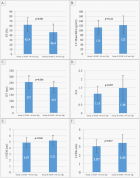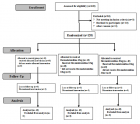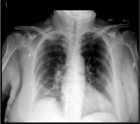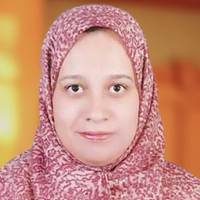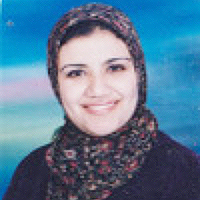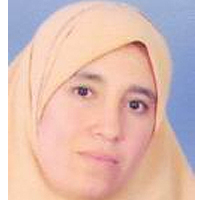Abstract
Research Article
Postpartum as the best time for physical recovery and health care
Shizuka Torashima*, Mina Samukawa, Kazumi Tsujino and Yumi Sawada
Published: 02 January, 2023 | Volume 7 - Issue 1 | Pages: 001-007
Aim: The current paper presents a subjective symptom survey regarding postpartum discomfort (Study 1) and a case study on postpartum care using the program developed based on the survey results (Study 2). Thereafter, health care during the postpartum period is discussed.
Methods: Study 1 analyzed 1638 postpartum women who completed the Subjective Fatigue Symptom Scale (SFSS) over the period from June 2012 to December 2019. Study 2 detailed the case of a 33-year-old primiparous woman who answered questions regarding the rehabilitation care program.
Results: The 1638 subjects included in Study 1 had a mean age of 32.4 ± 8.2 years and a mean postpartum duration of 4.3 ± 2.3 months. Subjective symptoms included lower back pain, shoulder stiffness, sleepiness, wanting to lie down, yawing, and eye strain. The case included in Study 2 showed certain psychological and physical changes following the exercise program. The results of Study 1 showed that motor system discomfort, such as stiff shoulders and lower back pain, occurred in women across all postpartum stages. Our results demonstrated that care and exercise geared toward improving motor system function are imperative after childbirth. Meanwhile, the results of Study 2 imply that our rehabilitation program based on postpartum physical conditions had positive psychological and physical effects.
Conclusion: Taken together, our results suggest that continuing rehabilitative care based on the physical condition during each postpartum stage facilitates improvement in mothers’ physical and psychological discomfort.
Read Full Article HTML DOI: 10.29328/journal.jnpr.1001049 Cite this Article Read Full Article PDF
Keywords:
Postpartum; Health care program; Fatigue; Rehabilitation; Physical recovery
References
- Murkoff H. What to expect when you’re expecting. Aspect, Tokyo. 2004; 2-12.
- Uemura Y. Midwifery Care–Knowledge and practice of midwifery techniques leading the present to the future learning from history. Japan J. Perinat. Care 2019; 38: 788-794.
- Gasquet BD. Akachan to isshoni! Perine no ekusasaizu: Osan no maekara shitteokitai sango no kotsubanteikingun to bodeitoritomento (Let’s Do It with Your Baby! Perineal Exercises: Postpartum pelvic floor muscles and body treatment to learn before childbirth). Medicus Shuppan, Tokyo. 2013. 21-89. (in Japanese).
- Torashima S. Understanding of physical conditions of postpartum women and proposal of implementation of postpartum exercise care - A questionnaire of 460 participants and a case study on the practice of health exercise guidance.Project Research. 2014; 29-41.
- Japan Sports Agency Commissioned Project: Female Athlete Development & Support Projects: Strategic Support Program for Female Athletes: How to Support Female Athletes
https://www.jpnsport.go.jp/jiss/Portals/0/images/contents/woman/reserch/20181018. pdf, released in October, 2018. (Last accessed June 20, 2020). (in Japanese).
- Sipko T, Grygier D, Barczyk K, Eliasz G. The occurrence of strain symptoms in the lumbosacral region and pelvis during pregnancy and after childbirth. J Manipulative Physiol Ther. 2010 Jun;33(5):370-7. doi: 10.1016/j.jmpt.2010.05.006. PMID: 20605556.
- Ramin AN, Macchi VE, Porzionato AN, De Caro RA, Stecco CA. Fascial continuity of the pelvic floor with the abdominal and lumbar region. Pelviperineology 2016; 35: 3-6.
- Fan C, Guidolin D, Ragazzo S, Fede C, Pirri C, Gaudreault N, Porzionato A, Macchi V, De Caro R, Stecco C. Effects of Cesarean Section and Vaginal Delivery on Abdominal Muscles and Fasciae. Medicina (Kaunas). 2020 May 27;56(6):260. doi: 10.3390/medicina56060260. PMID: 32471194; PMCID: PMC7353893.
- Gluppe SL, Hilde G, Tennfjord MK, Engh ME, Bø K. Effect of a Postpartum Training Program on the Prevalence of Diastasis Recti Abdominis in Postpartum Primiparous Women: A Randomized Controlled Trial. Phys Ther. 2018 Apr 1;98(4):260-268. doi: 10.1093/ptj/pzy008. PMID: 29351646; PMCID: PMC5963302.
- Sperstad JB, Tennfjord MK, Hilde G, Ellström-Engh M, Bø K. Diastasis recti abdominis during pregnancy and 12 months after childbirth: prevalence, risk factors and report of lumbopelvic pain. Br J Sports Med. 2016 Sep;50(17):1092-6. doi: 10.1136/bjsports-2016-096065. Epub 2016 Jun 20. PMID: 27324871; PMCID: PMC5013086.
- Hayashi Y. Physiological changes in postpartum mother’s body. Japan J. Perinat. Care. 2019; 38: 937-940. (Abstract in English).
- Torashima S. A survey of the physical conditions from two to nine months postpartum first report: Comparing in advanced maternal age group and the other groups. Japan J. Matern. Health 2016; 57: 297-304. (Abstract in English).
- Torashima S. The influence of a single course health promotion class on physical and mental condition—Empirical study with mothers in early parenthood. Hokkaido Journal of Physical Education, Health and Sports Sciences. 2018; 53: 15-26, (Abstract in English).
- Working Group for Occupational Fatigue: Jikaku-sho Shirabe (A Subjective Symptom Survey). http://square.umin.ac.jp/of/service.html. 2002. (Last accessed on June 20, 2020).
- Sekijima K. Physical conditions of mothers in early parenthood. Japan J. Matern. Health 2012; 53: 375-382. (Abstract in English).
- Norman E, Sherburn M, Osborne RH, Galea MP. An exercise and education program improves well-being of new mothers: a randomized controlled trial. Phys Ther. 2010 Mar;90(3):348-55. doi: 10.2522/ptj.20090139. Epub 2010 Jan 7. PMID: 20056720.
Figures:
Similar Articles
-
Achilles Tendon Injuries: Comparison of Different Conservative and Surgical Treatment and RehabilitationAlessandro Bistolfi,Jessica Zanovello, Elisa Lioce,Lorenzo Morino,Raul Cerlon,Alessandro Aprato*,Giuseppe Massazza. Achilles Tendon Injuries: Comparison of Different Conservative and Surgical Treatment and Rehabilitation. . 2017 doi: 10.29328/journal.jnpr.1001006; 1: 039-053
-
Factors affecting muscle strength in cancer patients receiving chemotherapyJiro Nakano*,Shun Ishii,Takuya Fukushima,Ayumi Natsuzako,Junya Sakamoto,Minoru Okita. Factors affecting muscle strength in cancer patients receiving chemotherapy. . 2017 doi: 10.29328/journal.jnpr.1001008; 1: 056-066
-
Determining the use and value of social support in Telerehabiliation Interventions for individuals with Multiple Sclerosis: A narrative synthesis reviewLucinda Pidgeon,Trudy Pelton*,Andrew Soundy. Determining the use and value of social support in Telerehabiliation Interventions for individuals with Multiple Sclerosis: A narrative synthesis review. . 2017 doi: 10.29328/journal.jnpr.1001014; 1: 120-136
-
Rehabilitation of proximal humerus fractures: An environmental scan of Canadian physiotherapy practice patternsLowell L Kwan,Norma J MacIntyre*. Rehabilitation of proximal humerus fractures: An environmental scan of Canadian physiotherapy practice patterns. . 2017 doi: 10.29328/journal.jnpr.1001013; 1: 104-119
-
Physical Therapy for Transverse Myelitis: A Case ReportAllison Buchanan,Kelli J Wilkerson,Han-Hung Huang*. Physical Therapy for Transverse Myelitis: A Case Report. . 2018 doi: 10.29328/journal.jnpr.1001017; 2: 015-021
-
Perceptive and Rehabilitative Muscle Recruitment Facilitation Secondary to the use of a Dynamic and Asymmetric Spine Brace in the treatment of Adolescent Idiopathic Scoliosis (AIS)Maurizio Falso*, Laura Forti,Silvia Iezzi,Gloria Cottali,Eleonora Cattaneo,Marco Zucchini,Franco Zucchini. Perceptive and Rehabilitative Muscle Recruitment Facilitation Secondary to the use of a Dynamic and Asymmetric Spine Brace in the treatment of Adolescent Idiopathic Scoliosis (AIS). . 2018 doi: 10.29328/journal.jnpr.1001021; 2: 054-079
-
Influence of an integrated rehabilitative treatment on the modification of body representation in patients affected by Unilateral Spatial NeglectMaurizio Falso*,Michela Delpero,Eleonora Cattaneo. Influence of an integrated rehabilitative treatment on the modification of body representation in patients affected by Unilateral Spatial Neglect. . 2018 doi: 10.29328/journal.jnpr.1001023; 2: 087-100
-
Functional Electrical Stimulation (FES): Clinical successes and failures to dateGad Alon*. Functional Electrical Stimulation (FES): Clinical successes and failures to date. . 2018 doi: 10.29328/journal.jnpr.1001022; 2: 080-086
-
TRIA-MF protocol as an innovative tool in the comprehensive treatment and outcome evaluation of lower limb amputees before and after prosthesis useMaurizio Falso*,Silvia Zani,Eleonora Cattaneo,Marco Zucchini,Franco Zucchini. TRIA-MF protocol as an innovative tool in the comprehensive treatment and outcome evaluation of lower limb amputees before and after prosthesis use. . 2019 doi: 10.29328/journal.jnpr.1001024; 3: 001-024
-
Postural and Kynematic effect of a new custom-made foot insole called “Prodynamic” in a cohort of patients affected by extrapiramidal diseaseMaurizio Falso*, Matilde Grillo,Anna Righetti,Franco Lopa,Lisa Rocco,Emanuela Facchi. Postural and Kynematic effect of a new custom-made foot insole called “Prodynamic” in a cohort of patients affected by extrapiramidal disease. . 2019 doi: 10.29328/journal.jnpr.1001027; 3: 039-081
Recently Viewed
-
Leiomyosarcoma in pregnancy: Incidental finding during routine caesarean sectionToon Wen Tang*,Phoon Wai Leng Jessie. Leiomyosarcoma in pregnancy: Incidental finding during routine caesarean section. Clin J Obstet Gynecol. 2021: doi: 10.29328/journal.cjog.1001094; 4: 092-095
-
Adult Neurogenesis: A Review of Current Perspectives and Implications for Neuroscience ResearchAlex, Gideon S*,Olanrewaju Oluwaseun Oke,Joy Wilberforce Ekokojde,Tolulope Judah Gbayisomore,Martina C. Anene-Ogbe,Farounbi Glory,Joshua Ayodele Yusuf. Adult Neurogenesis: A Review of Current Perspectives and Implications for Neuroscience Research. J Neurosci Neurol Disord. 2024: doi: 10.29328/journal.jnnd.1001102; 8: 106-114
-
Late discover of a traumatic cardiac injury: Case reportBenlafqih C,Bouhdadi H*,Bakkali A,Rhissassi J,Sayah R,Laaroussi M. Late discover of a traumatic cardiac injury: Case report. J Cardiol Cardiovasc Med. 2019: doi: 10.29328/journal.jccm.1001048; 4: 100-102
-
A two-phase sonographic study among women with infertility who first had normal sonographic findingsKalu Ochie*,Abraham John C. A two-phase sonographic study among women with infertility who first had normal sonographic findings. Clin J Obstet Gynecol. 2022: doi: 10.29328/journal.cjog.1001117; 5: 101-103
-
Sinonasal Myxoma Extending into the Orbit in a 4-Year Old: A Case PresentationJulian A Purrinos*, Ramzi Younis. Sinonasal Myxoma Extending into the Orbit in a 4-Year Old: A Case Presentation. Arch Case Rep. 2024: doi: 10.29328/journal.acr.1001099; 8: 075-077
Most Viewed
-
Evaluation of Biostimulants Based on Recovered Protein Hydrolysates from Animal By-products as Plant Growth EnhancersH Pérez-Aguilar*, M Lacruz-Asaro, F Arán-Ais. Evaluation of Biostimulants Based on Recovered Protein Hydrolysates from Animal By-products as Plant Growth Enhancers. J Plant Sci Phytopathol. 2023 doi: 10.29328/journal.jpsp.1001104; 7: 042-047
-
Sinonasal Myxoma Extending into the Orbit in a 4-Year Old: A Case PresentationJulian A Purrinos*, Ramzi Younis. Sinonasal Myxoma Extending into the Orbit in a 4-Year Old: A Case Presentation. Arch Case Rep. 2024 doi: 10.29328/journal.acr.1001099; 8: 075-077
-
Feasibility study of magnetic sensing for detecting single-neuron action potentialsDenis Tonini,Kai Wu,Renata Saha,Jian-Ping Wang*. Feasibility study of magnetic sensing for detecting single-neuron action potentials. Ann Biomed Sci Eng. 2022 doi: 10.29328/journal.abse.1001018; 6: 019-029
-
Pediatric Dysgerminoma: Unveiling a Rare Ovarian TumorFaten Limaiem*, Khalil Saffar, Ahmed Halouani. Pediatric Dysgerminoma: Unveiling a Rare Ovarian Tumor. Arch Case Rep. 2024 doi: 10.29328/journal.acr.1001087; 8: 010-013
-
Physical activity can change the physiological and psychological circumstances during COVID-19 pandemic: A narrative reviewKhashayar Maroufi*. Physical activity can change the physiological and psychological circumstances during COVID-19 pandemic: A narrative review. J Sports Med Ther. 2021 doi: 10.29328/journal.jsmt.1001051; 6: 001-007

HSPI: We're glad you're here. Please click "create a new Query" if you are a new visitor to our website and need further information from us.
If you are already a member of our network and need to keep track of any developments regarding a question you have already submitted, click "take me to my Query."









